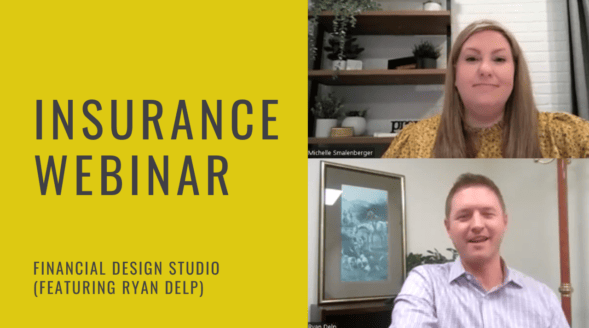Life Insurance: Death Benefit Types [Video]
by Trevore Meyer, CFP® / April 27, 2021Thanks for joining me in another video in our life insurance series. This is video three of our four part series. Today’s video is all about life insurance death benefit types and face amounts. Our first video overviewed what is life insurance? In the second video we discussed what goes in, and what comes out? If you haven’t had an opportunity to watch the first two I would encourage you to spend some time watching those videos. I will be referring to a couple of things we talked about there.
Also another quick disclaimer, at Financial Design Studio, Inc. we do not sell any life insurance. We do review it as a part of each client’s financial plan because of how critical it is to your plan.
All the previous videos have had a mix between term and permanent provisions and things that can apply to both. This video will be all about permanent policies and things associated with the death benefit types and the face amounts with each of those contracts.
When you originally purchased your policy you were probably told that you were purchasing X number of thousands of dollars of insurance. You were also told what the death benefit option may be. It’s ok if you don’t remember. Most people are not aware of the death benefit option on their contract. We will go through an example here in a moment so you can see why it’s so important.
Death Benefit Example
John purchased a contract 10 years ago. He purchased a $500,000 contract with required premiums of $3,500/year. Let’s say today the cash value on that contract is $48,000. Simple straight forward examples. The interesting part is depending on the death benefit option his beneficiaries could receive one of three different numbers. This is depending on which death benefit type was chosen.
Amount Beneficiaries Receive Can Differ
- Contract A-$500,000
2. Contract B- $548,000
3. Contract C- $535,000
Death Benefit Types
Option A contracts are considered a level death benefit option. This means no matter what the cash value of the contract is the beneficiaries will always be paid the face amount. In this case $500,000.
Contract B is called an increasing contract. This means as the cash value on the contract grows so does the death benefit option that gets paid out. In this case we are looking at $500,000, the face amount, plus the cash value of $48,000 totaling $548,000.
Option C contracts are considered a return of premium. In this case since we paid in 10 years of $3,500 premium that means we paid $35,000 in premiums therefore totaling $535,000.
What is the best contract?
You might think that option B is going to be the best because it results in the highest death benefits to your beneficiaries. While that could be the case sometimes that doesn’t always mean it’s the best for you and your family. We should step back and look at this. Instead of paying for the $500,000 of life insurance with an option A contract we are actually only paying for $452,000. How? The reason why is because we have a face amount of $500,000. The insurance company is keeping our $48,000. In reality our cost of insurance is based off of this $452,000 opposed to $500,000.
This is really important as you age and continue to get older as chances of your death become higher and higher. As you get older you are more likely to die so your cost of insurance is going to increase as you get older. As you have an option A contract the cost of insurance may actually slowly come down. This is because you have an increasing cash value to offset the increased cost of insurance. Which means for a later in life policy the option A contracts can make a lot of sense. They don’t get cost prohibitive as they would on an option B contract.
Figuring the best contract for you means going through your entire financial plan. Then determining what makes the most sense for you and your family.
Considerations for Contracts
Let’s talk through a quick planning point and consideration we can think through today. For example with permanent policies a great feature we talked about before is the cash value associated with them. If that cash value is offering to pay you 4% a year. That is actually really nice if we compare it to a checking or savings account. That rate can be really challenging to match in those accounts. If we want to fully utilize that great interest rate return, how would we go about doing that with the least amount of risk possible?
You may think with the option A contract we can add a lot of money to our insurance policy. For example, if we add $20,000 to our cash value we are reducing the cost of our insurance and we are capturing the 4%. Here’s the catch, if something were to happen to you and you were to die shortly after you add the $20,000. Your family would be left without that $20,000 in your bank account that they would have otherwise had.
In a situation like this when we are reviewing this policy we may offer to the client to transition your policy from an A to a B policy. The reason is as we add our $20,000 to the cash value, even though we are paying more for the cost of the insurance, we are always protected because the $548,000 is our cash value plus the face amount of the contract. This isn’t always the case though. We may even want to look at an option C policy. Instead of just going out and buying a new policy you may utilize your contracts purchased in years past.
If you have a contract you would like to review or have detailed questions on it we would love to go through that with you. If you have any questions let us know and feel free to reach out.
Ready to take the next step?
Schedule a quick call with our financial advisors.
Recommended Reading
Insurance Webinar
Our insurance webinar walks you through the basic insurance policies, what you may be missing, and an audience Q&A session.
Endorsements for Your Insurance Coverage [Video]
In this excerpt, Ryan Delp, insurance agent with Bradish Associates, breaks down insurance endorsements he looks to add for extra coverage.

Trevore Meyer, CFP®
Trevore has nearly a decade helping families with their financial planning needs. He is incredibly passionate about helping folks visualize and explore what their ideal lives look like and following it up by helping them get there.

